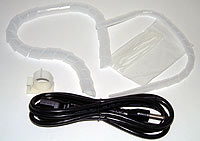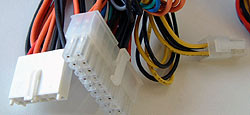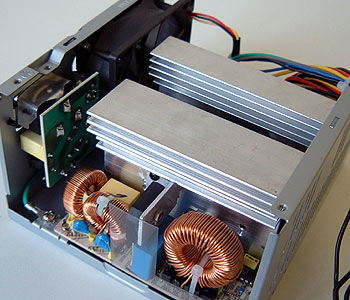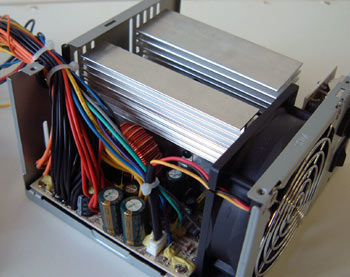While
there is no plastic mesh loom around the main bundle of wires for the ATX power
connector, Seasonic does include spiral plastic wrap to sheath the power cables. They also include
a mounting clip and small wire ties which certainly help keep the cables
organized once installed in the case.


While the computer industry
has made great strides in the past few years, most generic power supply
manufacturers have not kept up. What I mean by that is modern processors
(AthlonXP, Pentium 4's) draw their power from the
12V line, however most PSU's on the market are still built around
the 5V rail where the Pentium 2-3 processors drew their power from.
According to Intel, a Pentium 4 3 GHz processor draws approximately 9.7 amps
off the 12V rail itself, if you're using a generic 300-400W PSU that potentially leaves very
little room for any other devices. You can guess what happens when the
processor does not get enough current; hard locks and spontaneous reboots when
under heavy load.
Inside the SS-400AGX
Seasonic uses a detachable 80mm SuperRed CHA8012CB-A
(closest I could find) 80x80x20mm fan to ventilate the internal components. At full
load the fan spins 3000 RPM and pushes 32.5 CFM while producing 34 dB of noise.
To help keep vibrations at
a minimum, Seasonic have placed rubber spacers between the fan and casing of
the power supply. During testing, the power supply was absolutely silent and the only
way we could hear it when I placed my head within 10 cm of the fan!


Even though Seasonic claims that the SS-400AGX is one of the
cooler running power supplies on the market, with few ventilation holes I have a
hard time seeing how the PSU can meet that claim. Even with the ambient
temperature below 20 degrees celsius, the air coming out from the power supply
was quite warm.
Unlike the PC Power & Cooling
Turbo-Cool 510-PFC we reviewed earlier, the innards of the SS-400AGX are relatively sparse.
The enthusiast might be a bit disappointed to see that Seasonic does not
have any internal adjustable potentiometers - but realistically speaking, letting users poke
around with the voltage levels can be pretty hazardous unless they
are educated on the matter.
